Nokia Lumia 830 Review
by Brett Howse on November 25, 2014 8:00 AM EST- Posted in
- Smartphones
- Microsoft
- Lumia
Camera
The Lumia 830 carries the PureView branding on the camera, which Nokia has saved for the heavy hitting cameras. As the line has evolved, the PureView brand appears to be for phones with Optical Image Stabilization (OIS), although as with any branding that may change in the future. The Lumia 830 is by far the lowest end PureView camera so far, with just a 1/3.4” sensor size attached to the OIS mechanism and the six lens optics. The 10.0 megapixel count results in the typical for Lumia 1.1 µm pixel size. The sensor is also a 16x9 native format. The flash is handled by a single LED. It is good to see OIS in a midrange device such as this but the small sensor and small pixel size is going to limit the amount of data that can be collected in dim lighting even with OIS allowing the exposure time to be a bit longer than normal.
To measure camera performance we start with the ISO12233 chart which allows us to test for spatial resolution as well as the amount of processing done by the ISP to get rid of aliasing.
ISO12233 Test Chart
With a smaller sensor size and the same small pixel size, the Lumia 830 cannot do the pixel binning of its PureView brethren. The ISO chart reveals that this is not the same PureView as other devices with the same branding.

Once we dig into the chart a bit, we can see that the Lumia 830 starts to struggle around the 13 mark on our chart. This is not all about pixel count either, as the lower resolution iPhone can capture up until the 15 mark. The Lumia 930, with its much larger 1/2.5” sensor can pretty much resolve the entire chart and the Lumia 1020 with the PureView 41 MP camera easily resolves the sagittal lines.
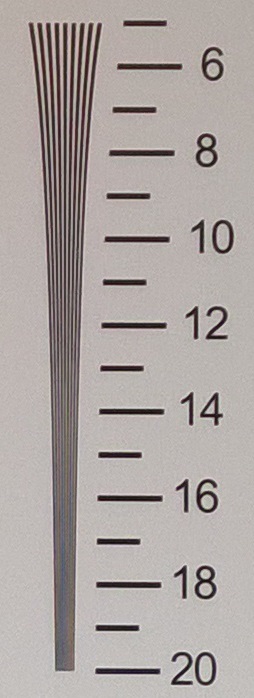
The tangential lines show a similar story, with the Lumia 830 unable to resolve after around the 13 mark. With a 10 MP sensor, I would have hoped to see it resolve at least the same as the iPhone.
Next we will take a look at some controlled scenes.
Controlled Scenes
The Lumia 830 does a good job on a well-lit scenes. The amount of detail is good, and the color balance is very good as well. These shots were taken in full auto, so while it would be possible to correct the Lumia 1020 white balance with the manual controls, most of the time people just leave the camera in auto so it is important for the device to get the right cast.
To stress the camera under poor lighting, we set the light box to 5 lux and leave the flash off. The Lumia 830 does a decent job here again, once again getting the white balance spot on. As compared to the Lumia 1020 photo, there is quite a bit more noise in the final image which is not surprising with the sensor size difference. If you were not going to crop this image it would be very usable.
Outdoor Scenes (Night)
Moving out of the comforts of home, I braved the elements to get some outdoor pictures. The first scene is a park bench which is lit by a low-pressure sodium-vapor light which has a distinctive yellow hue. This scene is dark enough that the image preview on the phone is pretty hard to make out.
The Lumia 830 does a good job with this scene. It keeps some of the yellow cast of the sodium light, but the result is a very usable photo. If you zoom in on it, there is more noise than the 1020 but the overall result is very good.
The picture of the grocery store tells a similar tale. The Lumia 830 gets a better white balance than the Lumia 1020 and the result is a good photo. The Lumia 1020 as always struggles to get the correct white balance when in auto mode even though the resultant picture has much less noise.
Outdoor Scenes (Day)
Moving to daytime, there is generally ample light that even small sensors have no issue getting a reasonable photo.
The Lumia 830 had no issues during daylight with any of the subjects. This picture makes a great comparison with the detail loss as compared to the Lumia 1020. Please ignore the color differences between the photos as the sun ducked behind a cloud, but instead look at the detail of a zoomed in image.
 Lumia 830 (Left) vs Lumia 1020 (right) in Cropped comparison - view at full resolution to see full effect
Lumia 830 (Left) vs Lumia 1020 (right) in Cropped comparison - view at full resolution to see full effect
The Lumia 830 is a good camera for basic point and shoot smartphone photography but it lacks the imaging power of the other PureView phones such as the 930 and 1020. A 1/3.4” sensor and the much lower pixel count removes the ability to do pixel binning to improve the overall result, and it also removes the ability to do lossless zoom.
Another missing feature from the Lumia 830 as compared to the other PureView cameras is the ability to capture in RAW format.
As a still photograph camera, we still need to look at one more feature that can impact camera use – latency.
Capture Latency
Being able to take a photograph quickly can mean the difference between getting a great shot and missing the subject altogether. We have seen a great push in the industry in the last while to improve the focus latency, with some cameras now using phase detection and other tricks to increase the focus speed. The other half of that is the capture latency of taking the photo and saving it so that the camera app is ready to go again. We will start with focus. As with the performance benchmarks, I sampled several phones that may be shopped against the Lumia 830. If you want to check out the 830 against any other device, please visit our benchmark comparison pages in Bench.
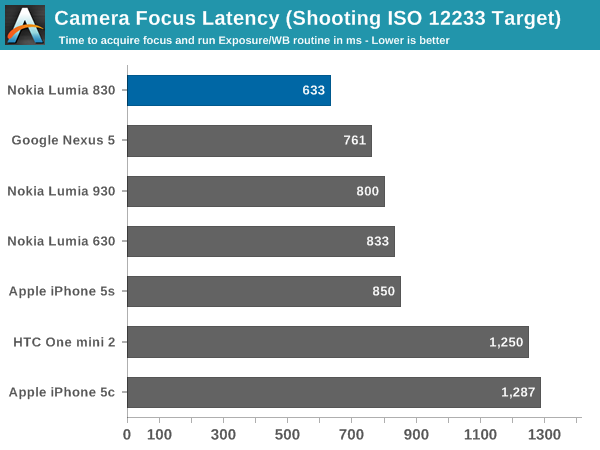
The Lumia 830 is the fastest Lumia I have tested for focus latency, with it occurring in just over 600 ms. While not the outright fastest device for focus we have ever tested, improvement is always welcome. Next up, we will look at the latency to initiate a photo save it to disk.
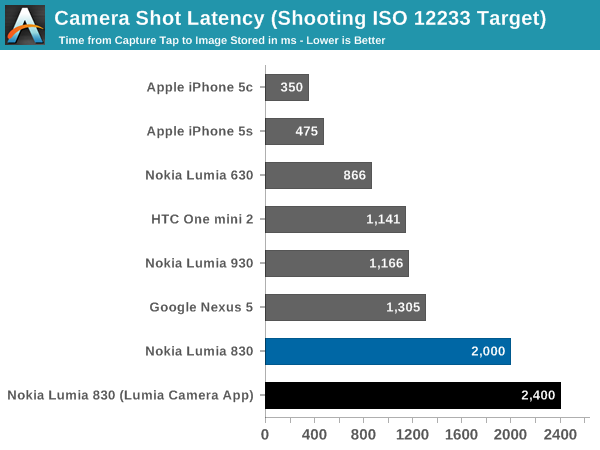
At IFA, Microsoft announced they were going to be launching a new camera app at the end of this year and it cannot come soon enough. The Lumia Camera app is especially slow, with a total capture latency of 2.4 seconds before it is ready for another shot. The default Windows Phone camera app is slightly faster at 2 seconds even. The Lumia 930 outperforms it here which likely means that it is being held back by the slower SoC onboard.
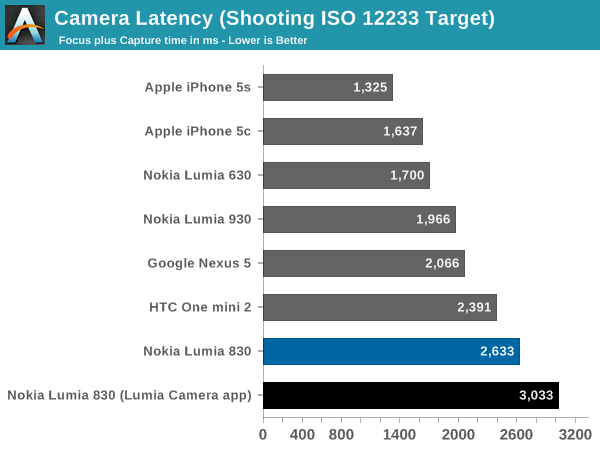
Total latency is the time to focus and the time to capture and save the image. The Lumia 830 is a very slow camera. It is hard to say anymore other than hopefully the new camera app improves this situation.
Video
The 830 has four microphones which allow it to capture video in Dolby Digital surround sound, which is a nice bonus. The video resolution and frame rate options are fairly sparse though, with the only options being 1080p or 720p at 24, 25, or 30 frames per second.
I did two videos with the first one being during the day and the second one at night.
The video during the day was during very high winds (50 km/h+) and with the default low pass filter enabled on the video the amount of wind noise was pretty good.
The night video shows the limits of the sensor quite clearly. OIS helps with the camera shake, but on still photography it allows for an increased exposure time to combat a small sensor. On a video, the sensor gets no such bonus and as such there is quite a bit of noise.


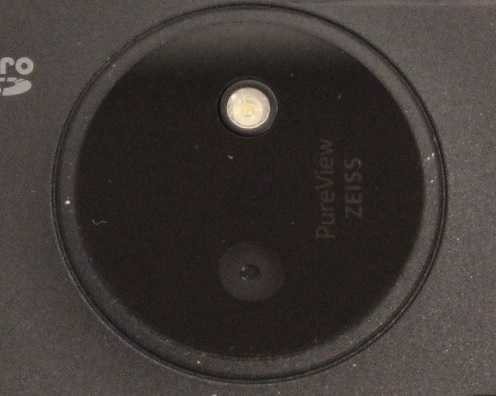
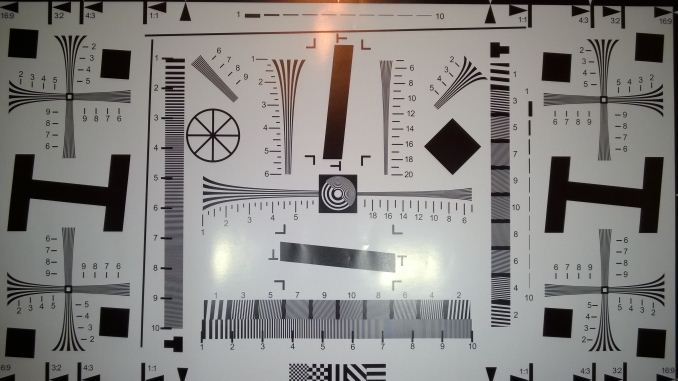


















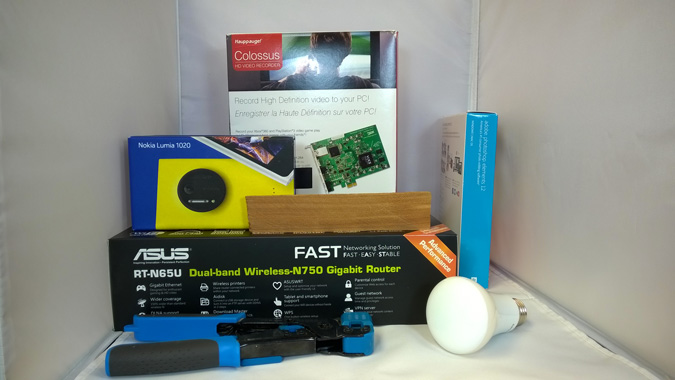


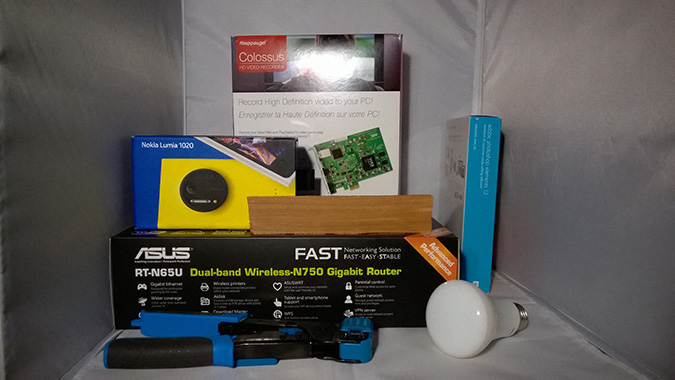


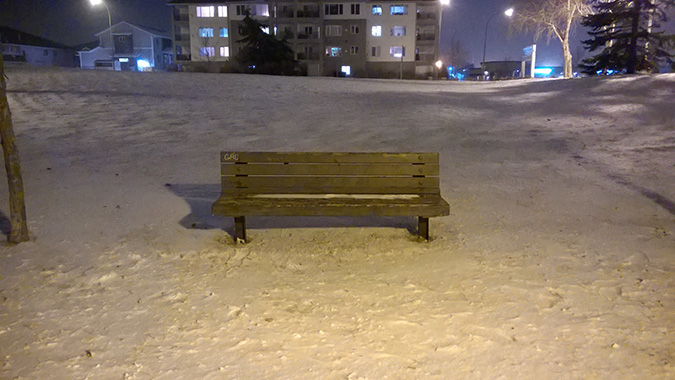


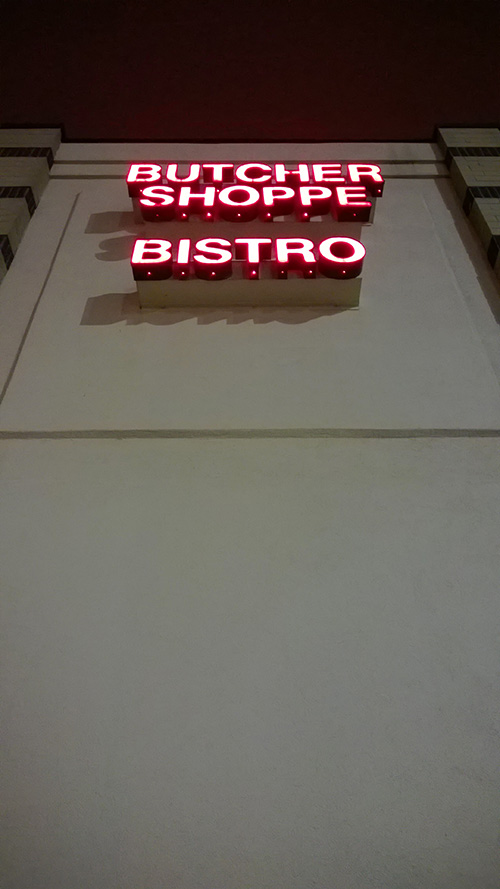















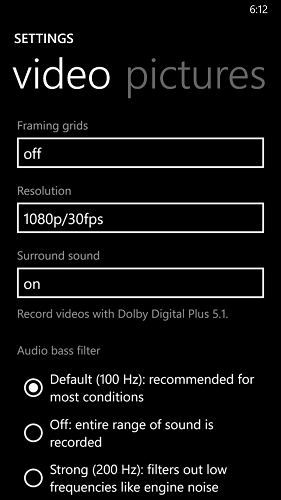








98 Comments
View All Comments
TheFlyingSquirrel - Tuesday, November 25, 2014 - link
The phone would have been so much more compelling if this came out last year or even more 1st half of the year before the newer Qualcomm chips started showing up in mid-range devices.PubFiction - Tuesday, November 25, 2014 - link
You can pretty much chalk up almost every windows phone to this same statement, would have been good if it was 6 months to a year earlier. They seriously cannot expect to do anything with their last place priority for phone development.tralalalalalala40 - Tuesday, November 25, 2014 - link
It's silly to mention megapixels when comparing cameras. By eye, a camera would have to be 4*8= 32 mp to be obviously better than an 8mp camera. What matters is more is sensor size/light intake/signal to noise/etc which has nothing to do with mp. (hint, 1080p is less than 2 megapixels...)ToTTenTranz - Tuesday, November 25, 2014 - link
I don't think Qualcomm sells the Snapdragon 600 in large quantities anymore, probably because the final price ended up too close to the Snapdragon 800/801, since it required an external baseband processor. My guess is the FireTV is the last "new" device getting those chips, as it doesn't need the extra baseband processor.I understand that getting the S610 could be too early for this Lumia 830. Though it's harder to understand why they didn't use the S410, since there are already lots of devices on the market using it and it's quite a bit faster than the old S400.
This makes me think that the Lumia division is still suffering from the same "inertial" problems as the old Nokia. This model would've made total sense during last year when the Moto G was reigning over the mid-end market.
Drumsticks - Tuesday, November 25, 2014 - link
I thought that the 830 was too early for S610 as well, but it's already available/shipping in several HTC Phones (their desire line or something?) and presumably some other OEMs as well.cheshirster - Friday, November 28, 2014 - link
What is the point in S410? It is not faster.S600 is older then first gen WP8 phones( 920 and 820). Imagine Nexus 4 battery life tests instead of actual L830 numbers and you will understand why it has S400.
simard57 - Tuesday, November 25, 2014 - link
I recently swapped my original Moto X for a Lumia 830. The X was my third Android phone and this is my 1st Windows Phone. I am pleased with the 830 and feel it gives me a longer time between charges than my X did. Having a replaceable battery is a nice perq as well.One "issue" I have stuggled with is a way to import my google favorites from google Map. I exported the favorites into a KML file and was able to import them into www.bing.com/maps but regrettably, the web Bing Maps do not sync with Windows Phone Maps or Windows 8.1 Maps. I googled it and learned that Phone Maps syncs with Windows 8.1 Maps - and it does BUT there is no apparent way to import a KML file (or any file) into the Windows MAPS or Phone MAPS program. Please do not tell my I have to manually enter each of the entries!
What's up with that Microsoft? This IS a required feature!!!
cheshirster - Friday, November 28, 2014 - link
Phone maps sync with here.com. Maybe this would help.simard57 - Monday, December 1, 2014 - link
is there a way to move my location library from the Google ecosystem into the Microsoft one?I will keep looking - but I do not see a way to import KML or any file into here.com
simard57 - Monday, December 1, 2014 - link
also - does here.com sync with windows 8.1 maps?sure feels like the maps situation in the Microsoft ecosystem is bit fragmented.